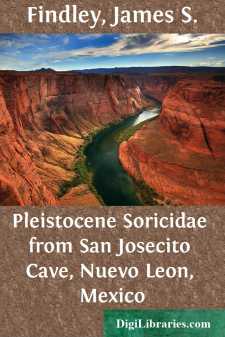Categories
- Antiques & Collectibles 13
- Architecture 36
- Art 48
- Bibles 22
- Biography & Autobiography 813
- Body, Mind & Spirit 142
- Business & Economics 28
- Children's Books 14
- Children's Fiction 11
- Computers 4
- Cooking 94
- Crafts & Hobbies 4
- Drama 346
- Education 46
- Family & Relationships 57
- Fiction 11829
- Games 19
- Gardening 17
- Health & Fitness 34
- History 1377
- House & Home 1
- Humor 147
- Juvenile Fiction 1873
- Juvenile Nonfiction 202
- Language Arts & Disciplines 88
- Law 16
- Literary Collections 686
- Literary Criticism 179
- Mathematics 13
- Medical 41
- Music 40
- Nature 179
- Non-Classifiable 1768
- Performing Arts 7
- Periodicals 1453
- Philosophy 64
- Photography 2
- Poetry 896
- Political Science 203
- Psychology 42
- Reference 154
- Religion 513
- Science 126
- Self-Help 84
- Social Science 81
- Sports & Recreation 34
- Study Aids 3
- Technology & Engineering 59
- Transportation 23
- Travel 463
- True Crime 29
Pleistocene Soricidae from San Josecito Cave, Nuevo Leon, Mexico
by: James S. Findley
Description:
Excerpt
Bones of a large number of vertebrates of Pleistocene age have been removed from San Josecito Cave near Aramberri, Nuevo León, México. These bones have been reported upon in part by Stock (1942) and Cushing (1945). A part of this material, on loan to the University of Kansas from the California Institute of Technology, contains 26 rami and one rostrum of soricid insectivores. Nothing seems to be known of the Pleistocene Soricidae of México. The workers cited do not mention them and no shrews are listed by Maldonado-Koerdell (1948) in his catalog of the Quaternary mammals of México. Comparison of these specimens with pertinent Recent material from México, the United States, and Canada leads me to the conclusion that they represent two genera and at least three species. The material examined is described below.
Sorex cinereus Kerr
One right ramus, bearing all three molars but lacking the other teeth and the tip of the coronoid process, needs close comparison only with certain of the smaller North American species of Sorex. From S. merriami of southeastern Wyoming, it differs in having a shorter, much shallower dentary, a shorter molar row, and a lower coronoid. In every particular it is identical with Sorex cinereus. Sorex cinereus from northern British Columbia and the specimen from Nuevo León differ from Sorex saussurei, S. obscurus, and S. vagrans in the ratio of the height of the coronoid to the length of the dentary. This ratio averages 49.6% in S. cinereus and 53.0% or more (up to 60.0%) in the other species. Microsorex hoyi differs from S. cinereus and from the specimen in question in deeper and shorter dentary, more robust condyle, dentary less bowed dorsally, molars shorter in anteroposterior diameter and higher in proportion to this dimension.
This record, as far as I can determine, constitutes a southward extension of the known Pleistocene or Recent range of this species of approximately 800 miles. The nearest known occurrence of S. cinereus in Recent times is in the mountains of north-central New Mexico. The species now has an extensive range in boreal North America and prefers mesic and hydric communities from which it rarely wanders. I know of no instance of the occurrence of the cinereous shrew in desert areas such as there are between many of the mountain ranges of southern New Mexico, Coahuila, and Nuevo León. Therefore, unless the habitat preferences of the species have changed since Pleistocene times, this find constitutes additional evidence that more humid conditions at one time prevailed in the regions mentioned.
Fragments of three other specimens of Sorex occur in the collection. One of these is a right ramus, C. I. T. No. 3943, and is complete except for the canine. The other two bear no numbers and I have designated them "A" and "B." "A" is a left ramus with the dentary broken off anterior to the canine and bears p4 and the canine. "B" is a right ramus bearing m2 and the roots of m3 and is broken off at the middle of the alveolus of m1. Each specimen has certain peculiarities but they resemble one another so closely that I regard all three as of the same species. The teeth, where comparable, are of essentially the same size and configuration. The horizontal rami of the dentaries are the same. The fossils differ, however, in the configuration of the coronoid process. In No. 3943 the coronoid is robust and inclined anteriorly with respect to a line drawn perpendicular to the dentary. The posterointernal ramal fossa (see Hibbard, 1953) is deeply excavated with a distinct superior border approximately halfway between its inferior border and the top of the coronoid. In addition to the mandibular foramen there is a small foramen immediately posterior to it opening into the posterointernal ramal fossa. I shall refer to this as the post-mandibular foramen....


